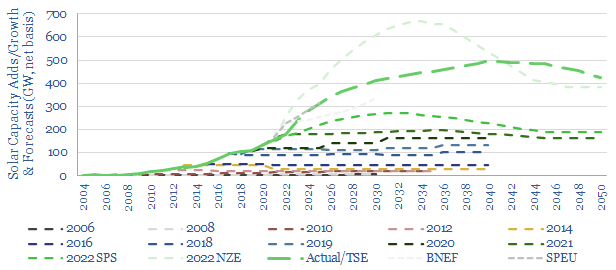Forecasts for future solar capacity growth have an unsatisfyingly uncertain range, varying by 3x. Hence this 15-page note discusses the future of solar. Solar capacity additions likely accelerate 3.5x by 2030 and 5x by 2040. But this creates bottlenecks, including for seven materials; and requires >$1trn pa of additional power grid capex plus $1trn pa of power electronics capex.
There is a 3x margin of uncertainty over future solar capacity growth. This is the range of forecasts that have crossed our screen. And the IEA has revised its assessment of 2030 solar capacity growth upwards by 3x in the past 3-years. We quantify the uncertainty on pages 2-3.
Definitions are an issue. Some forecasts of solar growth are discussing panel additions in GW, others are considering full AC solar project additions in GWe, and others still are quantifying net capacity change in GWe after deducting retirements. A summary of ‘who uses which definition’ is given on pages 4-5.
Our numbers see an acceleration to a peak of 500GWe of net capacity growth in 2040. The first reason that growth ‘peaks’ is that the average solar panel in the field today is 4-years old, and eventually panels get retired (page 6), and our full numbers are spelled out on page 7.
How much solar energy will be produced in 2030, 2040 and 2050? Our numbers, in “useful TWH” terms, are discussed on page 8.
Why can’t the numbers be higher? This would clearly be helpful. We want faster solar growth in order to achieve important goals in the energy transition, and to alleviate devastating energy shortages. With some help from Nigel Tufnel, in the cult 1980s rock comedy, This is Spinal Tap, we discuss the limits on solar capacity growth on page 9.
Seven materials are going to act as bottlenecks on growth. The numbers are truly staggering. Our solar trajectory raises total global demand for these materials by 20-120%. Fig 11, on page 11, is possibly the most important chart of energy transition bottlenecks that we have produced all year.
Bottlenecks also exist downstream of the solar projects, as our numbers require a vast expansion of power grids and power electronics. We quantify the growth for both of these markets at around $1trn each, with discussion and links to further research on pages 13-15.

